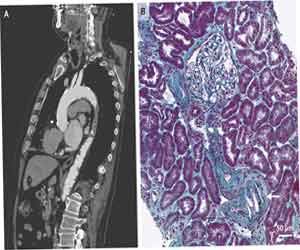- Home
- Editorial
- News
- Practice Guidelines
- Anesthesiology Guidelines
- Cancer Guidelines
- Cardiac Sciences Guidelines
- Critical Care Guidelines
- Dentistry Guidelines
- Dermatology Guidelines
- Diabetes and Endo Guidelines
- Diagnostics Guidelines
- ENT Guidelines
- Featured Practice Guidelines
- Gastroenterology Guidelines
- Geriatrics Guidelines
- Medicine Guidelines
- Nephrology Guidelines
- Neurosciences Guidelines
- Obs and Gynae Guidelines
- Ophthalmology Guidelines
- Orthopaedics Guidelines
- Paediatrics Guidelines
- Psychiatry Guidelines
- Pulmonology Guidelines
- Radiology Guidelines
- Surgery Guidelines
- Urology Guidelines
Case of cholesterol crystal embolization after TAVR- A report

Dr Hélène Lazareth and Dr Alexandre Karras, at Hôpital Européen Georges-Pompidou, Paris, France have reported a rare case of Cholesterol Crystal Embolization after Transcatheter Aortic-Valve Replacement. The case has appeared in the New England Journal of Medicine.
Cholesterol embolism syndrome should be suspected in a patient who develops worsening renal function, hypertension, distal ischemia, or acute multisystem dysfunction after an invasive arterial procedure. Atheroemboli may also occur spontaneously. Cholesterol embolism is a disease of persons ranging from middle-aged to elderly, with a minimum age of 50 years. The risk is greater for men than it is for women.Patients with multisystem cholesterol embolism syndrome have a poor prognosis. The mortality of acute multisystem organ failure resulting from cholesterol embolism syndrome is 58-90%
A 79-year-old man was admitted to the hospital after laboratory tests showed a serum creatinine level of 4.0 mg per deciliter (350 μmol per litre) (normal range, 0.7 to 1.2 mg per deciliter [60 to 100 μmol per litre]). He had no fevers, fatigue, weight loss, or myalgias. He had a history of ischemic cardiomyopathy and had chronic kidney disease (with a baseline serum creatinine level of 1.6 mg per deciliter [140 μmol per litre]), and he had undergone transcatheter aortic-valve replacement 1 month earlier. Physical examination showed cyanosis of both feet.
Additional skin examination showed no livedo reticularis, and eye examination showed no Hollenhorst plaques. Additional laboratory tests showed a total white-cell count of 6800 per microliter with 15% eosinophils (absolute eosinophil count, 1050 per microliter; normal value, <500). Computed tomographic angiography that had been performed before transcatheter aortic-valve replacement showed diffuse atheroma in the aorta, with evidence of complex plaques.
A renal biopsy performed during the current admission revealed multiple needle-shaped clefts in arteries and glomeruli, which confirmed cholesterol crystal embolization. The patient was treated with glucocorticoids and continued his previously prescribed treatment with aspirin and a statin. Hemodialysis was not initiated, and his renal function gradually improved. At a 6-month follow-up visit, the patient’s serum creatinine level was 2.2 mg per deciliter (190 μmol per liter).
For more details click on the link: DOI: 10.1056/NEJMicm1815615

Disclaimer: This site is primarily intended for healthcare professionals. Any content/information on this website does not replace the advice of medical and/or health professionals and should not be construed as medical/diagnostic advice/endorsement or prescription. Use of this site is subject to our terms of use, privacy policy, advertisement policy. © 2020 Minerva Medical Treatment Pvt Ltd